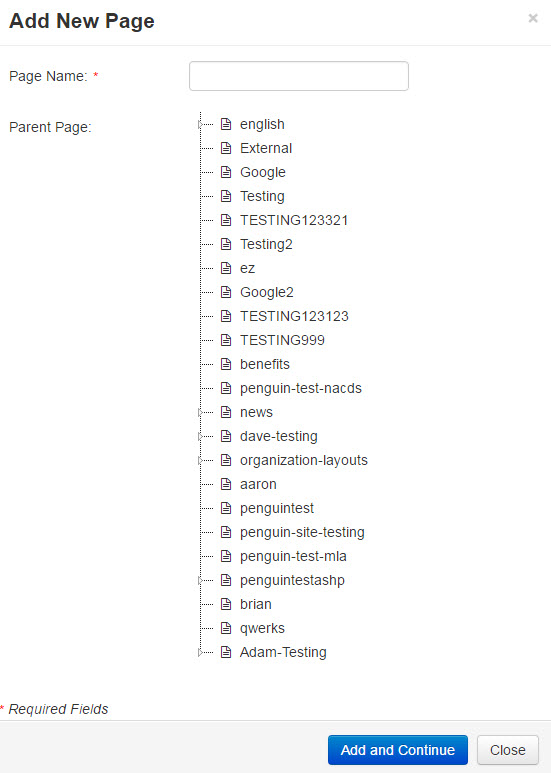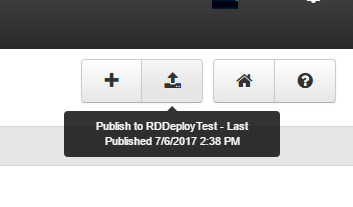- Index
- / Structure - Web Pages / Configuration
Site Structure - Web Page Configuration
When configuring a Web Page, you can click on the  button to Design the Page Layout of each page version. If you have multiple page versions, select the language from the drop down list to add and edit page content.
button to Design the Page Layout of each page version. If you have multiple page versions, select the language from the drop down list to add and edit page content.
New web pages are added on the Structure - Web Pages admin page.
- Click the
 button to add a new page.
button to add a new page.
- Set the Page Name
- If the page is a child to another page, select the Parent Page.
- Parent and child pages are useful in keeping pages in a folder-like structure. Each child page will include the parent page in the URL Path. In the example below, the "jobs" page URL Path will be "news/jobs".

- Click
 to go to the Configuration page where you can set the properties and versions for your page.
to go to the Configuration page where you can set the properties and versions for your page.
Clicking the Edit link next to a web page on the Structure - Web Pages admin page will take you to the Configuration page.
On the Configuration tab you can adjust the:
- URL Name and URL Path
- The URL Name is the name of the page that will display in the URL Path. The URL Path includes any parent pages.
- For example, the URL name for the page your are currently viewing is configuration. The URL Path is /help/admin/site/structure/webpages/configuration. The full URL is http://help.learnercommunity.info/help/admin/site/structure/webpages/configuration.
- The URL Name is the name of the page that will display in the URL Path. The URL Path includes any parent pages.
- Active From and Thru dates
- You can optionally set an active window for the page. Outside of this window, the page will not be visible or accessible to learners.
- Authentication Requirements
- When set to Yes, the page will require learners to log in before viewing. If they are not logged in, they will be redirected to the appropriate log in page.
On the Versions tab you can:
- Choose the page language. you can click
 to remove the language you selected.
to remove the language you selected.
- Note that you will not be able to remove the Default Language.
- Edit the Link Text. This is what will be displayed on the site page outline and it will be the default text displayed on the menu if the page is added to the menu.
- Edit the Broswer Title. This is what will display in search-engine results and in browser toolbars.
- Optionally add a Meta Description to provide a concise explanation of the contents of the web page. Meta Descriptions are commonly used on search engine results pages to display a preview for the given page.
- Optionally add Meta Keywords, which are used by search engines to determine the topic of the pages for search results.
This change was made because you can create external links anywhere on your site using the HTML Widget. Because you don't add any site content to an external URL page, there is no need to store it as a Web Page. When you configure your Menu, you can add an external link to your menu and it will function just as it did as a site page.
- Site settings are changed in the Staging environment, so that your changes can be reviewed and tested before your learners see them.
- Click
 when the changes you've made to your site are ready for your learners to see on the live site.
when the changes you've made to your site are ready for your learners to see on the live site.
- Typically, publishing requests takes only a minute to complete, but can take a bit longer if there are other publishing requests ahead of yours, or if the publishing service has been intentionally paused for some reason (e.g., a new release of the Learner Community software is in progress). Contact your administrator if publishing still hasn't completed after 60 minutes.
- Note that after clicking
 the site will be locked for publishing until the publish request is complete. This typically only a minute or so. During the time the site is locked, some features will be disabled such as modifying a web page configuration. You will not be able to publish the site again until the request has completed. If someone attempts to publish while the site is locked, the following message will display:
the site will be locked for publishing until the publish request is complete. This typically only a minute or so. During the time the site is locked, some features will be disabled such as modifying a web page configuration. You will not be able to publish the site again until the request has completed. If someone attempts to publish while the site is locked, the following message will display:

- When publishing has completed, you can hover over the
 button to see the last published date.
button to see the last published date.

- Note that Learning Products are published separately from the Site. Your site will need to be published the first time to create your live instance. Learning Products cannot be published until your site has been pushed live.
If your organization requires globalization of your content, you can add multiple language versions of your site pages. You must first go to the Configuration page to select the different languages that your site will support.
You will select the Default Language for your site on the Domains page.
When setting the page version, the default language will be automatically selected and you must go to the Versions tab to change the language.
When a page has multiple language versions, the learner's browser settings will determine which language page they see. For instance, if a learner's browser is set to Spanish, the Spanish version of the page will automatically be displayed (if that language version has been added to your site and to the page).
Note that the content on the web page will not be translated--the administrator must create the content on the page using the approprate language version.
- After adding the web page, click on the
 button to add a new language.
button to add a new language.
- Select the language from the dropdown list. If the desired language is not in the list, go to the Configuration page to add it to your site.
- Add or edit the Link Text. This is what will be displayed on the site page outline and it will be the default text displayed on the menu if the page is added to the menu.
- Add or edit the Broswer Title. This is what will display in search-engine results and in browser toolbars.
- Click
 . You will be returned to page configuration tab.
. You will be returned to page configuration tab.
- To add configuration or make changes to any page version, click on the Versions tab to set the configuration for the page version.
- Select the Language from the drop down list.
- Edit the Link Text. This is what will be displayed on the site page outline and it will be the default text displayed on the menu if the page is added to the menu.
- Edit the Broswer Title. This is what will display in search-engine results and in browser toolbars.
- Optionally add a Meta Description to provide a concise explanation of the contents of the web page. Meta Descriptions are commonly used on search engine results pages to display a preview for the given page.
- Optionally add Meta Keywords, which are used by search engines to determine the topic of the pages for search results.
- Click
 to remove that page version.
to remove that page version.
- Note that you will not be able to remove the Default Language.
